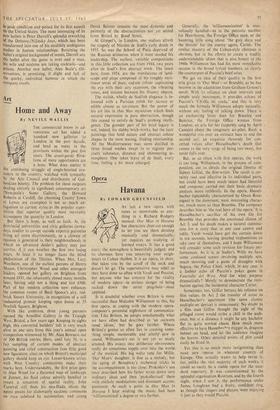Art
Home and Away
By NEVILE WALLIS
THE commercial boom in ad- venturous art has added a hundred new galleries to London in the past decade, and bred as many in the provinces within the past five years. The avant-garde flirta- tions of mere opportunists are a bore. What does matter is the continuing struggle of single-hearted Cru- saders in the country, watched with sympathy by the Arts Council and distributors of Gul- benkian bounty. The problem for these outposts dealing entirely in significant. contemporary art (Newcastle's Stone Gallery, the Howard Roberts at Cardiff, the charming County Town at Lewes are examples) is not so much an- tagonism to current styles. as the popular super- stition that superior quality must inevitably accompany the quantity in London.
But there is hope, as well as faith. As the provincial universities and civic galleries (nowa- days readier to co-opt outside experts) patronise living art more discriminately, so a climate of Opinion is generated in their neighbourhoods in Which an advanced dealer's gallery may just survive, if it can weather the first two losing Years. At least it no longer faces the . blind Philistinism of the Thirties. When Mrs. Lucy Wertheim, one of the earliest patrons of Henry Moore, Christopher Wood and other emergent leaders, opened her gallery on Brighton front around 1931, she reluctantly closed many months later, having sold not a thing and lost f500. Part of her moder,n collection now enhances the common rooms of asil Spence's airy, red- brick Sussex University, in recognition of a still undaunted pioneer keeping open house at 35 Norfolk Square, Brighton. , With like ambition, three young partners opened the Arnolfini Gallery in the Triangle West, Bristol, a few years ago. Keeping its sights high, this converted builders' loft is very much alive as one sees from this year's annual open competition winnowed by Mr. Alan Bowness out of 300 British entries. Here, until July 31, is a fair sampling of current modes of abstract painting and relief construction (too little good new figuration, alas) on which Bristol's municipal gallery should keep an eye. Lesser-known artists with West Country connections make their marks here. Understandably, the first prize goes to Alan Wood for a flattened map of landscape at Zennor, his fluid colour adroitly handled to create a sensation of spatial reality. John rurnival still finds his neo-Dada idiom the aptest means for ,elaborately sardonic comments on man subdued by automation; and young Derek Balmer remains the most dynamic and painterly of the abstractionists not yet seized from Bristol by Bond Street.
At Gimpel's, in London, one realises afresh the tragedy of Nicolas de Stars early death in 1955. So was the School of Paris deprived of the Russian aristocrat when it most needed his leadership. The earliest, variable compositions in this little collection are from 1944, two years after de Stael's first abstract work. The latest here, from 1954, are the translations of land- scape and plage composed of his roughly recti- linear areas of pure, radiant colour captivating the eye with their airy recession, the vibrating tones, and tension between his illusory objects.
The stylish, wholly de Staelish elegance is in- formed with a Parisian relish for facture as edible almost as ice-cream. But the power of his art lies in that Slav mysticism which finds natural expression in pure abstraction, though this ceased to satisfy de Sta.'s probing intelli- gence. The grander part of his brief legacy is not, indeed, his slabby briek-works, but the later paintings that hold nature and abstract colour shapes in the most teasing, illuding relationship. All the Mediterranean may seem distilled in three broad washes swept in to register pre- cisely substance, distance and shimmering at- mosphere. One takes leave of de Stael, every time, feeling a bit more enlarged.


































 Previous page
Previous page